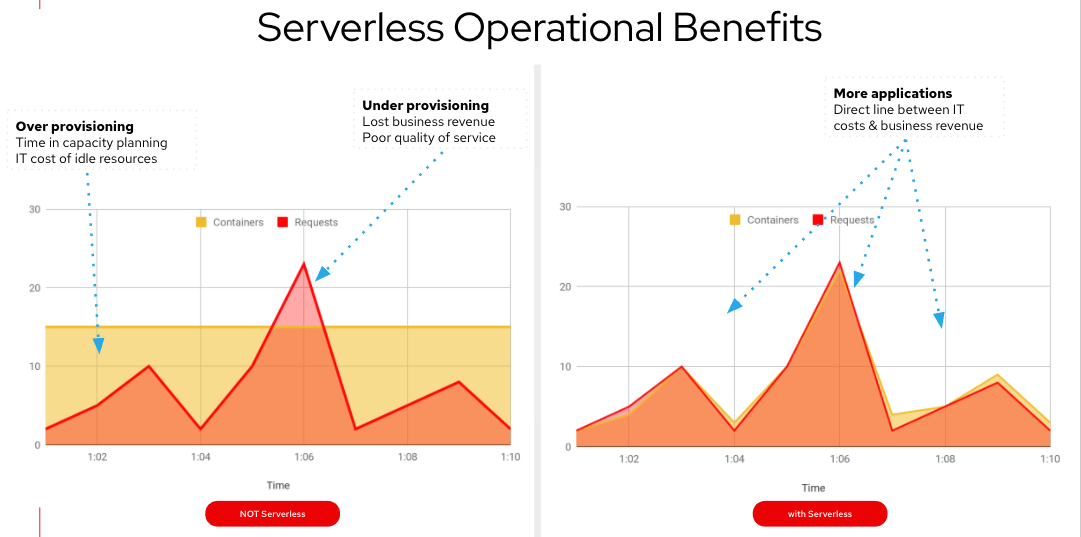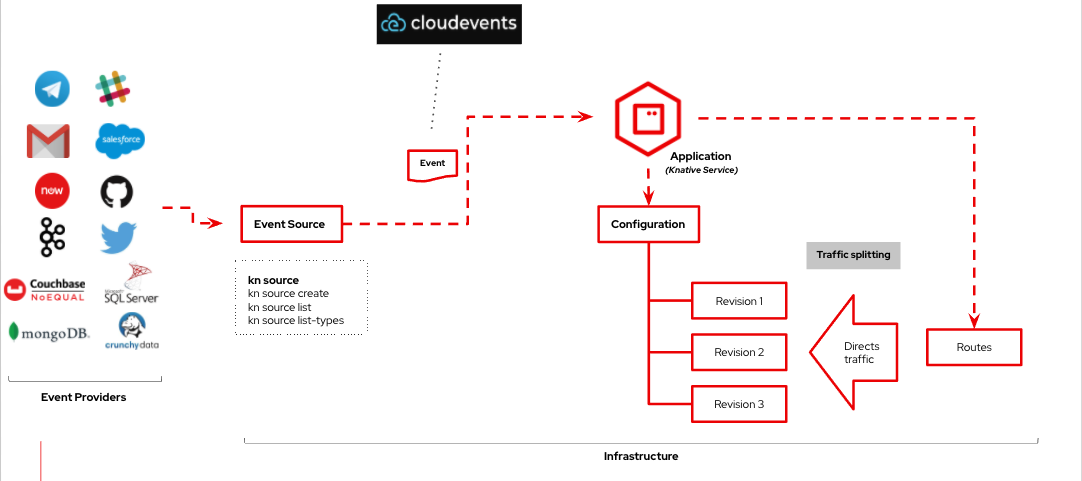We continue to provide information and suggestions on Red Hat trainings and tests with our participants as an approved Red Hat IT training center. Now that we've come to Red Hat's blog on "The benefits of serverless for the banking and financial services business" which explains the benefits of serverless for these 2 industries. Let’s read the blog written by Naina Singh from Red Hat.
The benefits of serverless for the banking and financial services industry
The financial services industry, like many industries, is currently undergoing a radical shift. In addition to the change to all-digital transactions, customers have come to expect comprehensive services that are able to meet their needs when, where and how they want them. In order to keep up with rapidly changing customer demands and remain compliant with industry regulations, financial services organizations must have the right IT infrastructure and processes in place.
And, as cloud-native—and more specifically, Kubernetes-native—development techniques continue to become the norm, the way developers at financial institutions work must also change, to a cloud-first approach. More and more, implementing a serverless architecture is what makes sense for financial organizations as they continue to transform their focus more on customer demands than IT infrastructure.
Developers working in banking and financial services can help achieve the goals of controlling operational costs, growing the ecosystem and adhering to regulatory standards, which require automation and secure, distributed systems. Let’s look at how the serverless platform can help.
What the serverless platform means for developers
To control costs and adhere to regulatory standards, a smart, more secure and distributed system that is based on a reliable ledger of transactions must be in place. Ideally, this is automated to reduce human error and mitigate the possibility of fraud.
Fintech startups have shaken traditional financial services organizations, and have forced new growth in the ecosystem and partnerships in order to be successful. A transparent system, aided by open source, can help grow the ecosystem.
Serverless is a cloud computing model that acts as a deployment platform. It lets developers focus on the code without worrying about the underlying infrastructure, by automatically scaling based on demand and then being able to scale back to zero while not in use. For developers, serverless mitigates the need for extensive architecture knowledge and responsibilities like management, provisioning, maintenance and, above all, scaling. These considerations allow developers to focus on, well, developing.
Developers in financial services organizations continue to embrace an open hybrid cloud development model, and they do so through the adoption of the Kubernetes platform for the cloud. This has made resource allocation for developers more streamlined and has also flattened the learning curve for first-time users. The combination of Kubernetes and serverless is also flexible and gives developers more options for their workloads. In fact, for mission-critical industries such as financial services, serverless is the next logical step, and can also help the evolution of high-performance cloud computing.
Technical drill-down of serverless
Red Hat contributes to Knative, an open source project that delivers the serverless experience through an abstraction layer that sits on top of Kubernetes. Knative brings serverless traits and benefits to containers.
Serverless applications are event-driven in nature. They follow a simple pattern: some event happens and that triggers your application. In Kubernetes, that means starting a container to handle that event. Your application might produce some result from the execution or process of the event and, once idle for enough time, that container can be scaled down to zero.
Your application could be a function or a microservice. One container can handle multiple requests and depending on the demand can scale up the containers to handle the load.
Serverless becomes instrumental in achieving the goal of controlling the operational cost for banks and FSI because the "always on" processes running on heavyweight runtimes (like J2E application servers) can consume a lot of expensive memory and require a lot of servers to scale and to meet high availability operational requirements.
This incurs the permanent costs associated with reserved CPUs and occupied memory. Serverless auto-scaling provides the ability to run more workloads on your infrastructure. Another benefit of serverless is that it allows users to deploy multiple revisions of the same application to enable traffic splitting and implement different deployment strategies (such as A/B deployment or canary deployment) to try out new features.
Beyond cost and performance, up-and-coming sustainability regulations demand companies to invest toward diminishing energy consumption, and serverless comes to help.

Now, let’s see how the serverless architecture could help.

Event-driven architecture (EDA) is based on the concept of a decoupled relationship between the producers that create the events and the event sinks (or consumers) that receive them, making your application reactive. As mentioned above, in a serverless paradigm an event triggers your application in a container and depending upon the demand one or more containers are spun up to handle the load and then torn down when idle.
Knative also provides the eventing infrastructure to build EDA-based applications consuming events that might be coming from different systems. Knative uses so-called Event Sources that use the CloudEvents specification to enable consistency, portability and accessibility. CloudEvents, a CNCF project, is a wrapper around the event data, which enables all the systems across the hybrid cloud to participate in the EDA solution.
Auditing is a big aspect of financial services. Depending on the amount of data stored in each log, it could be very resource-intensive. As financial services organizations work to streamline processes and be available to customers when, how and where they need services, serverless’s event-driven nature and auto-scaling could be a good solution. Serverless can also work well for artificial intelligence (AI) and machine learning (ML) workloads, as it offers scalability for processing large amounts of data, helps remove the operational overhead, and makes operations more cost-effective and lets the organization focus on what matters.
Red Hat OpenShift Serverless can help at scale
Red Hat OpenShift Serverless enables developers to build and deploy serverless, event-driven applications on Red Hat OpenShift. It provides an easy installation experience through an operator. Red Hat OpenShift Serverless applications can dynamically auto-scale, which makes it possible to run code and provision infrastructure only when it is necessary, and scale down to zero when not in use, saving time, money and resources.
The smoother developer experience helps organizations focus on providing business value and rapid go-to-market. Red Hat OpenShift Serverless packages and extends the open source project Knative that enables almost any container to run on OpenShift in a serverless manner. Knative abstracts away the complexities of Kubernetes to provide the components for a serverless deployment plane and eventing plane for creating scalable, distributed, elastic and cloud-native serverless applications.
Red Hat OpenShift Serverless also extends Knative to provide Serverless Functions that allows developers to just focus on code and lowers the entry barrier even further for developers, as they don’t need to worry about any compute resources, infrastructure configuration or even application configuration, allowing them to just focus on the code and the business value for a rapid go to market. These functions come with predefined runtimes and provide templates to jumpstart the code. This feature is still in Developer Preview.
With the addition of Serverless Functions, developers have the flexibility to choose the right tool for the job by either creating their own containers with more freedom to create their application or use Functions with their predefined defaults.
How serverless can benefit financial services
The financial services industry is adopting the hybrid cloud to innovate faster, as banking customers have come to expect immediate, always-on banking services whenever and wherever they want them. In the banking and financial services industry, in particular, specific regulations must be met, so the technology platform needs to be as secure as possible while being flexible and agile.
Some workload is being moved out of the organization's own data centers and into cloud providers’ managed services, adopting an as-a-service model for storage, compute, and services like databases and AI/ML engines.
Often the mixed on-premise and public cloud adoption strategy is pursued as some legacy, regulatory and intellectual-property-based applications users find as not suitable to move to the cloud.
Risk and compliance regulations force banks to guarantee business continuity and to not rely on one provider only. Hence, workloads and services are being distributed in multiple places now more than ever. In this hybrid cloud paradigm, events can connect all the distributed workload and scalability could utilize the resources efficiently. Serverless fits like a glove.
Serverless is an emerging technology and a deployment platform that would highly benefit the banking and financing industry due to its cost-effective and event-driven nature. It’s a design and service deployment model that maximizes on-demand-only cost as, when services are not required, the chargeback is nil. Financial services' highly variable workloads (for example, recurring yet temporary risk and repricing calculations) can benefit from Serverless.
Red Hat Serverless is part of the Red Hat OpenShift application platform, so no additional cost is involved and it can be simply enabled from within the OpenShift management interface.
To find out more on Red Hat OpenShift Serverless and how it makes it easier for your operations teams to manage the implementation of serverless capabilities, while also making it easier for your developers to create and manage event-driven deployments, please visit "How does Red Hat OpenShift Serverless help solve your business challenge?"
Singh, N. “The benefits of serverless for the banking and financial services industry”. June 11, 2021 https://www.redhat.com/en/blog/benefits-serverless-banking-and-financial-services-industry
With our wide selection of IT courses in Canada, you can explore a world of opportunities in the tech sector. Our extensive training programs are created to provide you with the skills required by today's digital world, whether you live in Ottawa, Toronto or Montreal. Our extensive course selection spans everything from programming and information security to cloud computing, leadership skills, ITIL, project management and soft skills. You will receive hands-on instruction and useful insights from our qualified instructors, who are experts in their area. You will reinforce what you'll learn with real life examples and our hands-on labs. You'll soon realize once the training is over, that you've improved your abilities- which will take you one step forward compared to your competitors. Our training programs come with internationally recognized certifications, giving you a competitive edge in Canada's job market. We are committed to supporting your career goals by offering one of the most comprehensive IT and soft-skill training catalogue with flexible learning options. Join our vibrant tech-focused community, establish connections with industry leaders, and embark on a transformative career journey.